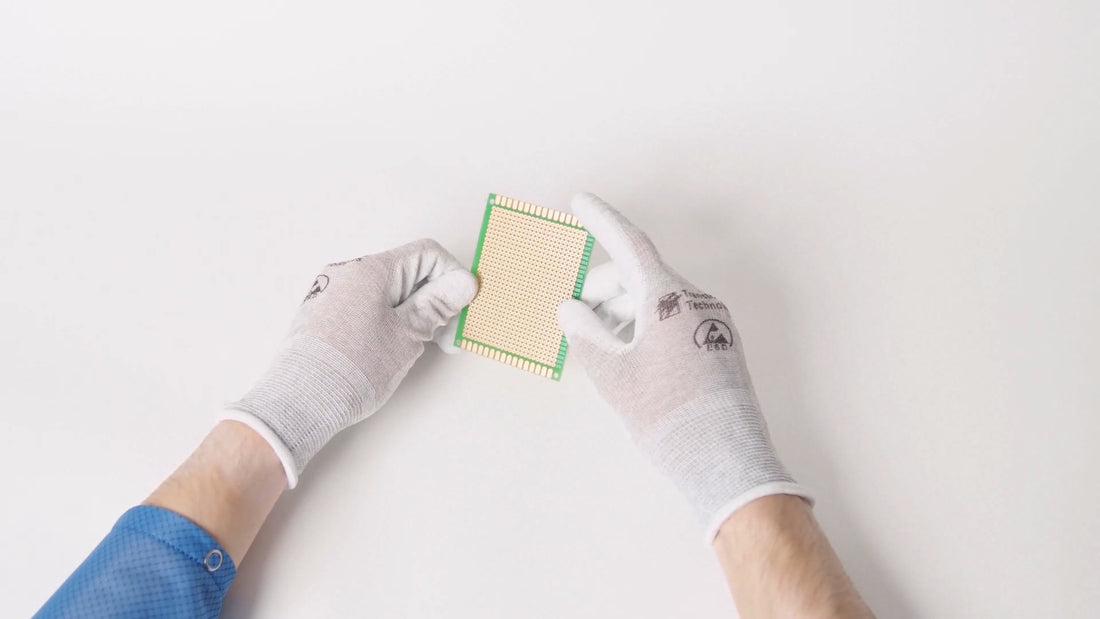
What are ESD Gloves and Why You Need Them
What are ESD Gloves and Why You Need Them
What are ESD Gloves? If you work in an industry that involves handling sensitive electronic equipment or flammable or explosive materials, you may have heard of ESD gloves. But what are ESD gloves and why are they important? In this article, we will explain what ESD gloves are, how they work, and what benefits they offer.
What is Static Electricity?
Static electricity is the electric charge that accumulates on the surface of an object when it is rubbed against another object. This phenomenon is called triboelectric charging and it occurs when electrons are transferred from one object to another due to friction. The object that loses electrons becomes positively charged, while the object that gains electrons becomes negatively charged.
Static electricity is usually harmless and can be observed in everyday situations, such as when you comb your hair, rub a balloon on your sweater, or walk on a carpet. However, static electricity can also cause serious problems in certain industries, such as electronics, medical, automotive, paint line, and petrochemical. In these industries, static electricity can damage or destroy sensitive electronic components, ignite flammable or explosive materials, or contaminate products with dust, dirt, or oils.
What are ESD Gloves?
ESD gloves are specialized gloves that protect workers from static electrical discharges. They are made with a special type of material that prevents the build-up of static electricity, which can cause damage to sensitive equipment. ESD gloves are typically made of synthetic fibers such as nylon, polyester, rayon, and spandex, which have low electrical conductivity. Some ESD gloves also have carbon fibers or metal threads woven into the fabric to enhance the anti-static properties.
ESD gloves are designed to protect workers and products from the harmful effects of static electricity, such as electric shocks, sparks, fires, and damage to electronic components. ESD gloves are also used to prevent contamination of products by dust, dirt, and oils that can be transferred by human hands.
How do ESD Gloves Work?
ESD gloves work by dissipating or neutralizing the static charge that builds up on the surface of the gloves. There are two main ways that ESD gloves can achieve this:
- Dissipative: Dissipative ESD gloves allow the static charge to flow through the gloves and dissipate to the ground or another conductive object. Dissipative ESD gloves have a moderate level of electrical resistance, which prevents the static charge from flowing too quickly and causing a shock or a spark. Dissipative ESD gloves are suitable for low to medium risk applications, such as electronic assembly, testing, or repair.
- Neutralizing: Neutralizing ESD gloves cancel out the static charge by creating an opposite charge on the surface of the gloves. Neutralizing ESD gloves have a high level of electrical resistance, which prevents the static charge from flowing at all. Neutralizing ESD gloves are suitable for high risk applications, such as cleanroom, medical, or paint line.
What are the Benefits of ESD Gloves?
ESD gloves offer many benefits for workers and products, such as:
- Safety: ESD gloves protect workers from electric shocks, sparks, fires, and explosions that can result from static electricity. ESD gloves also protect workers from injuries or infections that can result from cuts, abrasions, or chemicals that can occur during work.
- Quality: ESD gloves protect products from damage or degradation that can result from static electricity. ESD gloves also protect products from contamination or interference that can result from dust, dirt, oils, or electromagnetic interference that can occur during work.
- Efficiency: ESD gloves improve the efficiency and productivity of work by reducing the need for rework, repair, or replacement of damaged or defective products. ESD gloves also reduce the need for additional equipment, such as anti-static mats, wrist straps, or ionizers, that can increase the cost and complexity of work.
How to Choose the Right ESD Gloves?
Choosing the right ESD gloves depends on several factors, such as:
- Type: There are different types of ESD gloves available in the market, depending on the material, coating, size, and design. Some of the common types are nylon, polyester, rayon, spandex, carbon fiber, and metal thread ESD gloves. Each type has its own advantages and disadvantages, depending on the application, environment, and preference of the user.
- Performance: The performance of ESD gloves is measured by various parameters, such as surface resistance, static decay time, and resistance to the ground. These parameters indicate the anti-static performance of the gloves, as well as the comfort, durability, and cleanliness of the gloves. The performance of ESD gloves should comply with the relevant standards and regulations, such as ANSI/ESD S20.20, EN 16350, and IEC 61340.
- Application: The application of ESD gloves determines the level of risk and the requirements of the work. Different applications have different needs and challenges, such as temperature, humidity, cleanliness, precision, and safety. The application of ESD gloves should match the type and performance of the gloves, as well as the user’s preference and comfort.
Conclusion
ESD gloves are essential for workers who handle sensitive electronic equipment or flammable or explosive materials. ESD gloves can prevent static build-up and discharge, ensuring the quality and performance of the products and the safety and efficiency of the workers. ESD gloves are available in various types, sizes, and designs, depending on the material, coating, and performance. Choosing the right ESD gloves depends on the application, environment, and preference of the user. ESD gloves are a smart and simple way to protect yourself and your products from static electricity.
